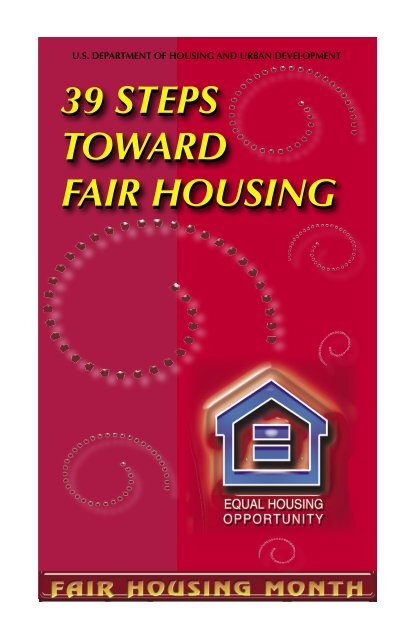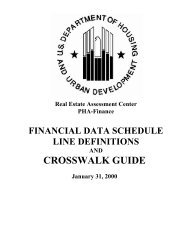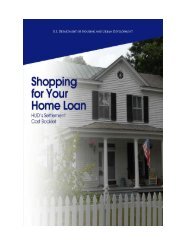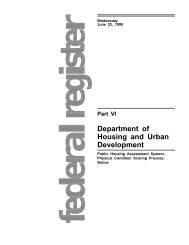39 Steps - HUD
39 Steps - HUD
39 Steps - HUD
Create successful ePaper yourself
Turn your PDF publications into a flip-book with our unique Google optimized e-Paper software.
U.S. DEPARTMENT OF HOUSING AND URBAN DEVELOPMENT<br />
<strong>39</strong> STEPS<br />
TOWARD<br />
FAIR HOUSING
Preamble<br />
The <strong>39</strong> <strong>Steps</strong> Toward Fair Housing<br />
depicts the issues, cases, developments and<br />
achievements that have been a part of this nation’s<br />
efforts to end discrimination and create equal housing<br />
opportunities for all since the Fair Housing Act was<br />
passed in April 1968. And although equality in<br />
housing remains elusive to many minorities, <strong>HUD</strong><br />
continues to enforce current fair housing laws and<br />
policies with conviction, provide education to the<br />
public about their fair housing rights, and reach out<br />
to the housing industry to build the kinds of alliances<br />
that will help ensure that every resident of this nation<br />
is afforded the opportunity to live where they choose.<br />
As we take the next steps toward fair housing, let us<br />
move forward under the guiding principle:<br />
“Fair Housing: It’s Not An Option;<br />
It’s the Law.”
YEAR<br />
STEPS TOWARD FAIR HOUSING<br />
1968<br />
1969<br />
1970<br />
1971<br />
1972<br />
1973<br />
Enactment of the Fair Housing Act- April 11, 1968. The<br />
Fair Housing Act, contained in Title VIII of the Civil Rights<br />
Act of 1968, prohibits discrimination in the sale, financing<br />
or rental of housing because of race, color, religion, and<br />
national origin.<br />
<strong>HUD</strong> issued the Title VIII Field Operations Handbook that<br />
institutionalized a formal complaint process.<br />
Shannon v. United States Department of <strong>HUD</strong>, 436 F.2d<br />
809 (3rd Cir. 1970), involved a decision by <strong>HUD</strong> to<br />
approve the development of a project in an urban renewal<br />
area that was racially and economically integrated. The<br />
plaintiffs claimed that the development of subsidized, lowincome<br />
housing in their neighborhood would destroy the<br />
existing racial and economic balance. The court held that<br />
<strong>HUD</strong> had to develop an institutional system for assessing<br />
the racial and socio-economic impact of the location of its<br />
projects.<br />
Project Sentinel, a non-profit corporation, was founded. It<br />
primarily assists individuals who face housing problems<br />
such as discrimination, repairs, deposits, privacy, dispute<br />
resolution, and mortgage foreclosure. A group of leaders<br />
from the corporate, educational and labor communities, as<br />
well as local fair housing advocates, founded the agency,<br />
which has grown steadily since it was founded. Project<br />
Sentinel is now the largest such agency in Northern<br />
California, serving an overall population of 3.5 million.<br />
<strong>HUD</strong> implemented project selection criteria for funding<br />
affordable housing developments. These criteria are used<br />
to rank a project’s location by considering whether the site<br />
is in a non-minority concentrated, minority concentrated,<br />
or mixed area. The criteria provided a racial and socioeconomic<br />
framework for reviewing the impact of <strong>HUD</strong>’s<br />
project approval on neighborhoods where the development<br />
will be located.<br />
Enactment of Section 504 of the Rehabilitation Act of 1973,<br />
which prohibits discrimination on the basis of disability<br />
in programs and activities conducted by <strong>HUD</strong> or those<br />
receiving financial assistance from <strong>HUD</strong>.<br />
2<br />
<strong>39</strong> STEPS TOWARD FAIR HOUSING
1974<br />
1975<br />
1976<br />
1977<br />
1978<br />
1979<br />
Sex is added as a protected class under the Fair Housing<br />
Act.<br />
Southern Burlington County N.A.A.C.P. v. Township of<br />
Mount Laurel, 67 N.J. 151 (1975) (commonly known as<br />
Mount Laurel I). In this case, the plaintiffs challenged the<br />
zoning ordinance of Mount Laurel Township, New Jersey<br />
on the grounds that the town operated to exclude low and<br />
moderate income persons from obtaining housing in the<br />
municipality. The Supreme Court ruled that a developing<br />
municipality may not use a land use regulatory scheme in<br />
order to prevent low and moderate-income persons from<br />
obtaining housing in the municipality.<br />
Congress amended the Equal Credit Opportunity Act to<br />
prohibit discrimination on the basis of race, color, religion,<br />
national origin, age, or receipt of public assistance.<br />
Congress enacted the Community Reinvestment Act<br />
(“CRA”). This act encourages banks to meet the credit<br />
needs of the local communities in which the banks<br />
operate. This includes addressing the needs of low-to<br />
moderate-income neighborhoods. The CRA responded<br />
to the often underdeveloped and inadequate flow of<br />
capital funds into low-income neighborhoods to aid in<br />
the fostering of neighborhood development, economic<br />
growth, and wealth building.<br />
A federal district court in Ohio held, for the first time,<br />
that the 1968 Fair Housing Act prohibited insurance<br />
redlining.<br />
Gladstone Realtors v. Village of Bellwood, 441 U.S. 91<br />
(1979). In this case heard before the Supreme Court,<br />
residents accused two brokers of racial steering thereby<br />
impeding the homeowner’s access to the benefits of<br />
living in an integrated setting. The Supreme Court held<br />
that the village and homeowners in a racially changing<br />
area have standing to challenge steering practices<br />
as indirect victims of housing bias. Furthermore, the<br />
Court determined that a municipality could be injured<br />
when its racial composition is adversely affected by race<br />
discrimination.<br />
3<br />
<strong>39</strong> STEPS TOWARD FAIR HOUSING
1980<br />
1981<br />
1982<br />
1983<br />
The Fair Housing Assistance Program (FHAP) received<br />
its first Congressional appropriation. FHAP is a <strong>HUD</strong><br />
program that provides financial assistance to state<br />
and local agencies enforcing fair housing laws that are<br />
“substantially equivalent” to the Fair Housing Act.<br />
Majors v. Housing Authority of the County of Dekalb, 665<br />
F.2d 454 (5th Cir. 1981). A tenant with a documented history<br />
of mental illness kept a dog in her apartment despite the<br />
housing authority’s “no pets” policy. The housing authority<br />
refused to waive the “no pets” policy and brought eviction<br />
proceedings. The tenant filed a complaint in federal<br />
district court alleging that the housing authority violated<br />
Section 504 of the Rehabilitation Act by failing to waive its<br />
“no pets” policy as a reasonable accommodation for her<br />
disability. The district court granted the housing authority’s<br />
motion for summary judgment and the tenant appealed.<br />
The court of appeals held that the housing authority had<br />
deprived the tenant of the benefits of the housing program<br />
by enforcing the “no pets” rule, reasoning that waiving<br />
the “no pets” rule would allow the tenant to fully enjoy<br />
the benefits of the program and would place no undue<br />
burdens on the housing authority.<br />
Havens Realty Corp. v. Coleman, 455 U. S. 363 (1982).<br />
Complainants alleged respondents engaged in racial<br />
steering in violation of Section 804 of the Fair Housing<br />
Act. The complainants included a prospective renter, two<br />
testers and HOME, a fair housing organization located<br />
in Richmond, Virginia. The Supreme Court held that the<br />
testers had standing to sue because they alleged that the<br />
neighborhood was damaged by the denial of interracial<br />
associations, and that the fair housing organization<br />
had standing to sue because the owner’s racial steering<br />
practices impaired HOME’s ability to provide housing<br />
counseling and referral services.<br />
Housing and Urban-Rural Recovery Act of 1983 created<br />
the housing voucher program as an alternative to Section<br />
8 rent certificates. These vouchers may afford families<br />
wider housing choices.<br />
4<br />
<strong>39</strong> STEPS TOWARD FAIR HOUSING
1984<br />
1985<br />
1986<br />
1987<br />
1988<br />
McDiarmid v. Economy Fire and Casualty Co, 604 F. Supp.<br />
105 (S.D. Ohio 1984). In this case, the Federal District<br />
Court of Ohio held that the Fair Housing Act applies to<br />
homeowners insurance discrimination, despite the fact<br />
that insurance is not specifically mentioned in the Act.<br />
In response to the Mount Laurel Decision, the New<br />
Jersey Legislature passed the state’s “Fair Housing Act,”<br />
accepting the premise that there was some constitutional<br />
obligation for municipalities to foster some degree of<br />
affordable housing. This legislation created the Council<br />
on Affordable Housing (COAH), an administrative agency<br />
established to facilitate the creation of affordable housing<br />
through regulatory guidance.<br />
Low-Income Housing Tax Credit (LIHTC), created through<br />
the Tax Reform Act of 1986, is a resource that allows state<br />
and local authorities to provide tax credits to developers<br />
that rehabilitate, acquire, or construct new housing<br />
that targets low-to moderate-income households, thus<br />
generating affordable housing.<br />
Section 561 of the Housing and Community Development<br />
Act of 1987, 42 U.S.C. 3616, established the Fair Housing<br />
Initiatives Program (FHIP) to strengthen the Department’s<br />
enforcement of the Fair Housing Act and to further fair<br />
housing. FHIP funds fair housing organizations and<br />
other non-profit groups to provide vital services to their<br />
communities. These services include providing education<br />
and outreach activities so that community members are<br />
aware of their rights. FHIPs also conduct investigatory and<br />
enforcement activities, offering an outlet for community<br />
members who may have fair housing related complaints.<br />
There are approximately 100 fair housing organizations<br />
nationwide. In FY 2007, FHIP is funded at $18,100,000.<br />
The Fair Housing Amendments Act (FHAA) added disability<br />
and familial status (the presence or anticipated presence<br />
of children under 18 in a household) to the Fair Housing<br />
Act’s list of protected classes. The FHAA made major<br />
changes to the enforcement actions under the Act, giving<br />
more authority to the Department of Housing and Urban<br />
Development to enforce the fair housing law. The FHAA<br />
extended the statute of limitations for federal lawsuits<br />
from 180 days to two years and removes a $1,000 cap on<br />
punitive damages. The FHAA also opened up new avenues<br />
5<br />
<strong>39</strong> STEPS TOWARD FAIR HOUSING
for enforcement of the rights of people with disabilities<br />
to live in the housing of their choice. For the first time,<br />
private-party transactions, where disability discrimination<br />
takes place, were subject to scrutiny in federal court.<br />
1989<br />
1990<br />
1991<br />
1992<br />
1993<br />
<strong>HUD</strong> v. Blackwell, 1989 WL 386958 (<strong>HUD</strong> ALJ 1989).<br />
This was the first case to be prosecuted under <strong>HUD</strong>’s<br />
enforcement authority created by the amended Fair<br />
Housing Act. The Administrative Law Judge (ALJ) held that<br />
the respondent violated the Fair Housing Act on the basis<br />
of race. The ALJ ordered respondents to sell the property<br />
in question to one of the complainants, as well as to pay<br />
actual damages of over $65,000 and a civil money penalty<br />
of $10,000.<br />
The Americans with Disabilities Act (ADA) was enacted<br />
on July 2, 1990. ADA prohibits private employers, state<br />
and local governments, employment agencies and labor<br />
unions from discriminating against qualified individuals<br />
with disabilities in job application procedures, hiring,<br />
firing, advancement, compensation, job training, and other<br />
terms, conditions and privileges of employment.<br />
Fair Housing Accessibility Guidelines were adopted by<br />
<strong>HUD</strong> to provide builders and developers with technical<br />
guidance on how to comply with the specific accessibility<br />
requirements of the Fair Housing Amendments Act of<br />
1988.<br />
Authority was given to conduct Moving to Opportunity for<br />
Fair Housing (MTO) as part of § 152 of the Housing and<br />
Community Development Act of 1992. MTO is a research<br />
demonstration that combined tenant-based rental assistance<br />
with housing counseling to help very low-income families<br />
move from poverty stricken urban areas to low-poverty<br />
neighborhoods.<br />
Empowerment Zone and Enterprise Community Programs<br />
were created under the Federal Omnibus Budget<br />
Reconciliation Act of 1993 as a strategy to promote<br />
revitalization efforts in economically distressed urban and<br />
rural areas.<br />
6<br />
<strong>39</strong> STEPS TOWARD FAIR HOUSING
1994<br />
1995<br />
1996<br />
1997<br />
1998<br />
Executive Order 12892, as amended, requires federal<br />
agencies to affirmatively further fair housing in their<br />
programs and activities, and provides that the Secretary<br />
of <strong>HUD</strong> will be responsible for coordinating this effort.<br />
The Executive Order also established the President’s Fair<br />
Housing Council, to be chaired by the Secretary of <strong>HUD</strong>.<br />
Housing for Older Persons Act of 1995, 42 U.S.C. §<br />
3607(b)(2)(C), amended the Fair Housing Act to permit<br />
a development’s occupancy by at least one person 55<br />
years or older in 80 percent or more of the housing units<br />
without the provision of significant facilities and services<br />
specifically designed to meet the physical or social needs<br />
of older persons. The provision also allows for a good<br />
faith defense in civil money damages when an individual<br />
reasonably relies on the housing for older persons<br />
exemption and has no actual knowledge that the facility<br />
is ineligible for the exemption and the facility has not<br />
stated formally in writing that the facility complies with<br />
the requirements for exemption.<br />
The Fair Housing Act Design Manual was published. This<br />
manual provides guidance regarding ways to design and<br />
construct housing that complies with the Fair Housing Act.<br />
The manual also explains the accessibility requirements of<br />
the Act, which must be incorporated into the design and<br />
construction of multifamily housing covered by the Act.<br />
<strong>HUD</strong> negotiated a voluntary “Best Practices Agreement”<br />
with the Mortgage Bankers Association and signs individual<br />
Best Practices Agreements with more than 117 lenders.<br />
These voluntary Agreements offered an opportunity for<br />
lenders to incorporate fair housing and equal opportunity<br />
principles into their mortgage lending standards, as well<br />
as increase low-income and minority lending.<br />
<strong>HUD</strong> v. Perland Corp. et al., 1998 WL 142159 (<strong>HUD</strong> ALJ<br />
1998). This case involved a complaint that was filed by<br />
the Will-Grundy Center for Independent Living, alleging<br />
discrimination in violation of the Fair Housing Act’s<br />
requirement that certain multifamily housing be designed<br />
and constructed to provide accessibility features. In this<br />
case of first impression, the Administrative Law Judge held<br />
that the respondents violated the Fair Housing Act’s design<br />
and construction requirements and orders the property<br />
owned by the respondents to be brought into compliance,<br />
7<br />
<strong>39</strong> STEPS TOWARD FAIR HOUSING
and that each respondent must pay a $3,000 civil money<br />
penalty. Furthermore, for those portions of the development<br />
no longer owned by the respondents, the ALJ ordered<br />
payment of $10,000 for future retrofits of the ground floor<br />
unit and common areas.<br />
1999<br />
2000<br />
2001<br />
2002<br />
2003<br />
2004<br />
Executive Order 13166, Improving Access for Limited<br />
English Proficiency (LEPs), requires that federal agencies<br />
take reasonable steps to provide meaningful access to<br />
federally conducted and assisted programs and activities<br />
for limited English proficient individuals. This involves<br />
determining language needs and providing appropriate<br />
language assistance to LEP individuals.<br />
Housing Discrimination Study (HDS 2000), a national<br />
housing discrimination study sponsored by <strong>HUD</strong> to measure<br />
patterns of racial and ethnic discrimination in urban housing<br />
markets, was released. The study involved three phases of<br />
paired testing focusing on the levels of housing discrimination<br />
experienced by African-Americans, Hispanics, Asian and<br />
Pacific Islanders, and Native Americans.<br />
Olmstead Executive Order 13217 was signed by President<br />
Bush implementing the Olmstead decision, which provides<br />
that the federal government should ensure placement<br />
of individuals with disabilities, whenever possible,<br />
in community settings rather than institutionalized<br />
environments.<br />
<strong>HUD</strong> and the National Association of Home Builders<br />
(NAHB) entered into a partnership to educate and train<br />
persons in the housing industry about their obligations to<br />
provide accessible housing to persons with disabilities.<br />
The National Fair Housing Ad Campaign, featuring public<br />
service announcements highlighting fair housing laws<br />
and providing victims of housing discrimination with vital<br />
information about their rights under the Fair Housing Act,<br />
was launched.<br />
The National Fair Housing Training Academy, which trains<br />
housing discrimination investigators of FHAP agencies on<br />
processes to use in conducting thorough, high quality and<br />
timely investigations, was established.<br />
8<br />
<strong>39</strong> STEPS TOWARD FAIR HOUSING
2005<br />
2006<br />
2007<br />
<strong>HUD</strong> and the Department of Justice (DOJ) issued a Joint<br />
Statement on Reasonable Accommodations under the Fair<br />
Housing Act that provides technical assistance to persons<br />
with disabilities and housing providers regarding their<br />
rights and obligations under the Act regarding reasonable<br />
accommodations.<br />
<strong>HUD</strong> charged Erie Insurance Group and five agencies<br />
licensed to sell Erie insurance products with violating<br />
the Fair Housing Act. Homeowners who lived in<br />
African-American neighborhoods were more likely<br />
to receive inferior insurance products from Erie than<br />
those homeowners living in white neighborhoods with<br />
comparable homes.<br />
<strong>HUD</strong> published its ‘‘Guidance to Federal Financial<br />
Assistance Recipients Regarding Title VI Prohibition<br />
Against National Origin Discrimination Affecting Limited<br />
English Proficient (LEP) Persons.” In accordance with the<br />
requirements of Executive Order 13166, this Guidance<br />
was published to clarify recipients’ obligations to LEP<br />
persons. The effective date of the Guidance is March 17,<br />
2007.<br />
9<br />
<strong>39</strong> STEPS TOWARD FAIR HOUSING

















